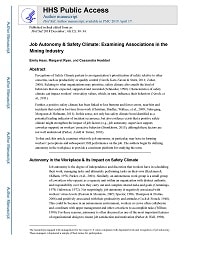Mining Publication: Job Autonomy and Safety Climate: Examining Associations in the Mining Industry
Original creation date: December 2018
Authors: E Haas, M Ryan, C Hoebbel
Perceptions of safety climate pertain to an organization’s prioritization of safety relative to other concerns, such as productivity or quality control (Naveh, Katz-Navon & Stern, 2011; Zohar, 2000). Relating to what organizations may prioritize, safety climate also entails the kind of behaviors that are expected, supported and rewarded (Schneider, 1990). Characteristics of safety climate can impact workers’ own safety values, which, in turn, influence their behaviors (Naveh, et al., 2011).
Further, a positive safety climate has been linked to less burnout and fewer errors, near-hits and incidents that result in lost time from work (Christian, Bradley, Wallace, et al., 2009; Nahr-gang, Morgesun & Hofmann, 2011). In this sense, not only has safety climate been identified as a potential leading indicator of incident occurrence, but also evidence exists that a positive safety climate might strengthen the impact of job factors (e.g., job autonomy, supervisor support, coworker support) on workers’ proactive behavior (Bronkhorst, 2015), although these factors are not well understood (Parker, Axtell & Turner, 2001).
To that end, this article examines what role job autonomy, in particular, may have in forming workers’ perceptions and subsequent OSH performance on the job. The authors begin by defining autonomy in the workplace to provide a consistent platform for studying the term.
